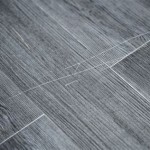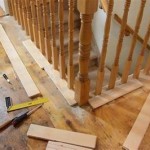How to Install Laminate Flooring Around Doorways
Installing laminate flooring can significantly enhance the aesthetics and functionality of a space. Successfully navigating the complexities around doorways, however, requires meticulous planning and precise execution. This article provides a comprehensive guide to installing laminate flooring seamlessly around door frames and casings, ensuring a professional and aesthetically pleasing final result.
Prior to commencing the installation, it is crucial to gather the necessary tools and materials. These include, but are not limited to: laminate flooring planks, underlayment, a measuring tape, a pencil, a circular saw or jigsaw, a tapping block, a pull bar, spacers, a hammer, a utility knife, safety glasses, and a door jamb saw or multi-tool with a flush-cut blade. The selection of high-quality tools will contribute significantly to the accuracy and ease of the installation process.
Accurate measurement is paramount for achieving a professional finish. Begin by measuring the width and length of the room, paying particular attention to the dimensions around doorways. These measurements will dictate the quantity of laminate flooring required and inform the initial layout. Consider the direction of the planks in relation to the doorway. Typically, running the planks parallel to the longest wall creates a visual sense of spaciousness. Note any irregularities in the doorway openings or wall alignment, as these will require adjustments during the cutting and fitting process.
Preparing the subfloor is an essential preliminary step. The subfloor must be clean, level, and dry. Any imperfections, such as bumps or dips, should be addressed. Minor irregularities can often be remedied with self-leveling compound. Remove any existing flooring, debris, or fasteners. A clean and level subfloor provides a stable foundation for the laminate flooring, preventing issues such as squeaking or unevenness after installation.
Key Point 1: Undercutting Door Jambs and Casings
Undercutting door jambs and casings allows the laminate flooring to slide neatly underneath, creating a clean and professional appearance. This technique also eliminates the need for unsightly quarter-round molding to conceal gaps. To begin, place a piece of laminate flooring (including the underlayment) against the door jamb. This serves as a guide for determining the cutting height. Using a door jamb saw or a multi-tool with a flush-cut blade, carefully undercut the door jamb to the appropriate height.
Ensure the blade is held flat against the laminate sample to achieve a consistent and accurate cut. Work slowly and deliberately, avoiding excessive pressure that could damage the door jamb or casing. After undercutting, remove any loose wood or debris. Test the fit of the laminate plank under the jamb. It should slide freely without binding. If necessary, make minor adjustments to the undercut until a perfect fit is achieved.
This process requires precision and patience. Rushing the undercutting process can result in uneven cuts or damage to the door frame. If using a multi-tool, select the appropriate blade and adjust the speed to prevent splintering. For thicker door jambs, multiple passes may be necessary to achieve the desired depth. The goal is to create a seamless transition between the laminate flooring and the door frame, eliminating the need for additional molding.
Safety precautions are crucial when using power tools. Always wear safety glasses to protect your eyes from flying debris. Use a dust mask to avoid inhaling wood dust. Ensure the work area is well-ventilated. Disconnect the power tool when changing blades or making adjustments.
Key Point 2: Proper Plank Placement and Cutting Techniques
Correct plank placement significantly impacts the overall aesthetic appeal and structural integrity of the installation. Begin by dry-laying a row of planks along the longest wall, using spacers to maintain a consistent expansion gap between the planks and the wall. This expansion gap allows for the natural expansion and contraction of the laminate flooring due to changes in temperature and humidity.
When approaching a doorway, measure the distance from the last full plank to the door frame. Transfer this measurement to a new plank, accounting for the expansion gap. Use a pencil and a straight edge to mark the cutting line. Utilize a circular saw or jigsaw to cut the plank to the required size. When using a circular saw, cut with the finished side facing up to minimize chipping. When using a jigsaw, cut with the finished side facing down.
For intricate cuts around door frames, consider using a template. Create a template from cardboard or heavy paper that matches the shape of the door frame. Trace the template onto the laminate plank and carefully cut along the traced lines. This technique is particularly useful for irregular shapes or complex curves. Remember to account for the expansion gap when creating the template.
During the cutting process, ensure the plank is securely supported to prevent movement or vibration. Use clamps to hold the plank in place if necessary. Employ a sharp blade to achieve a clean and accurate cut. Avoid forcing the blade through the plank, as this can result in splintering or damage. After cutting, inspect the edges of the plank for any imperfections. Remove any burrs or splinters with a utility knife or sandpaper.
Key Point 3: Securing Planks Around Doorways
Securing the planks around doorways requires careful attention to detail to ensure a stable and seamless transition. Utilize a tapping block and a pull bar to engage the locking mechanisms of the planks. The tapping block protects the edges of the planks from damage during the tapping process. The pull bar is used to engage the locking mechanisms in tight spaces, such as along walls or near doorways.
When installing planks under undercut door jambs, slide the plank into place and gently tap it into the locking mechanism. Use the pull bar to draw the plank tight against the adjacent plank. Ensure the planks are flush and aligned. Inspect the joints for any gaps or imperfections. If necessary, use a hammer and tapping block to further secure the connection.
In areas where the locking mechanisms cannot be fully engaged, consider using construction adhesive. Apply a thin bead of adhesive to the subfloor before installing the plank. This provides additional stability and prevents movement. However, use adhesive sparingly, as excessive adhesive can make future repairs or replacements difficult.
After installing all the planks around the doorway, inspect the entire area for any gaps or unevenness. Recut or replace any planks that do not fit properly. Clean the surface of the laminate flooring to remove any dust or debris. Consider using a transition strip at the doorway to provide a smooth and safe transition between the laminate flooring and any adjacent flooring surfaces. A transition strip can also help to conceal any minor imperfections or gaps.
Maintaining a consistent expansion gap around the perimeter of the room, including doorways, is essential for preventing buckling or warping of the laminate flooring. Remove the spacers after the installation is complete. The expansion gap will be concealed by baseboards or quarter-round molding (if not using the undercut method).
Proper acclimation of the laminate flooring prior to installation is crucial for achieving optimal results. Store the laminate flooring in the room where it will be installed for at least 48 to 72 hours. This allows the flooring to adjust to the room's temperature and humidity levels, minimizing expansion and contraction after installation. Failure to acclimate the flooring can result in gaps or buckling after installation.
Selecting the appropriate underlayment is another important consideration. Underlayment provides cushioning, reduces noise transmission, and helps to level minor imperfections in the subfloor. Choose an underlayment that is compatible with the specific type of laminate flooring being installed. Some laminate flooring products have pre-attached underlayment.
Finally, remember to dispose of all waste materials properly. Recycle any recyclable materials and dispose of non-recyclable materials in accordance with local regulations. A clean and organized work environment promotes safety and efficiency.

How To Install Laminate Flooring Around Doors And Cabinets

How To Lay Laminate Flooring Through A Doorway Blog Floorsave

Vinyl Plank Installation Tips For Doorways Halls Walls And Closets

Solving The Doorway Dilemma Laminate Flooring Tricks Doing Impossible Diy Howto

Installing Last Row Of Laminate Flooring In Hallways

How To Undercut A Door Frame Tutorial

How To Install Laminate Flooring Around Doors Builddirect

Installing Last Row Of Laminate Flooring In Hallways

Avoid Hassles With This Lvp Quick Tip For Door Jambs

Amazing Tricks How To Pass Two Doors Jambs With Vinyl Plank Flooring Lvp In A Narrow Hallway Diy
Related Posts








